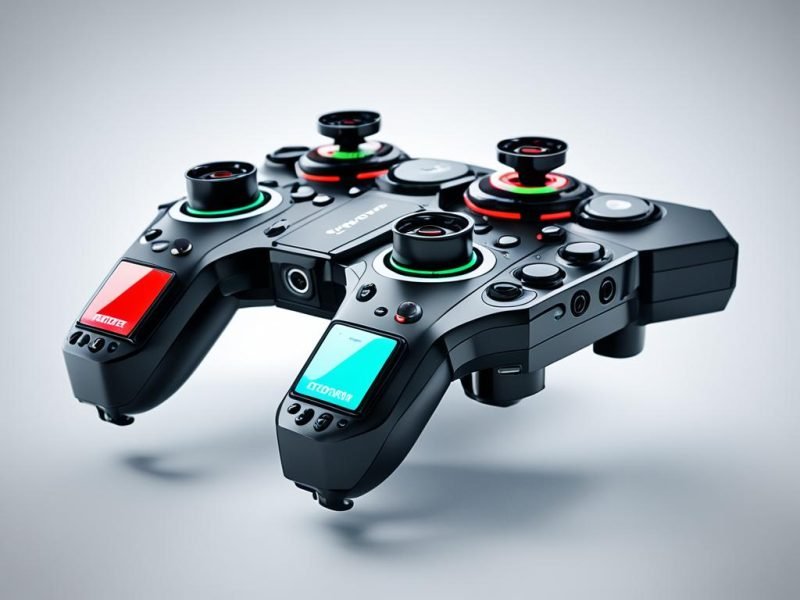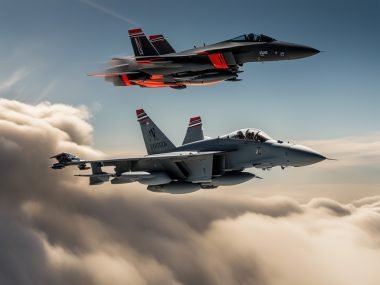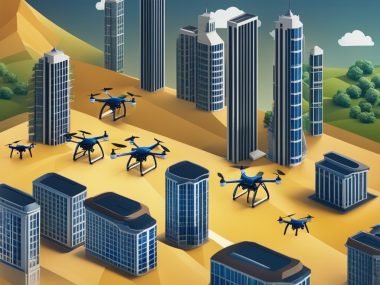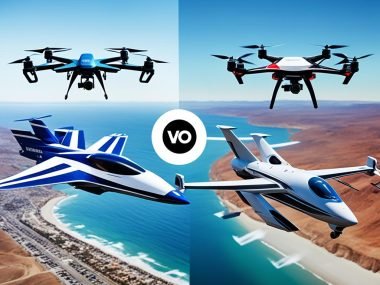When we look up at the sky and see drones flying, we wonder: Are all drone controls the same? Many people are learning to fly drones today. Knowing about drone control systems is very important. Flying a drone means feeling connected to it through the remote controller.
If you love taking amazing photos from the air, enjoy flying for fun, or need to map areas, choosing the right drone controls is key. Finding the best controller begins with understanding its features. This is important for a great flying experience.
Imagine delving into a world of signals and choices, where each sound and light guides a drone’s flight. Having the right controller lets your drone move beautifully in the air. It’s like starting a wild musical piece that lets your drone soar.
Key Takeaways
- Recognizing that each drone remote controller has unique properties, essential for proper drone maneuvering.
- Insight into the importance of familiarizing oneself with different drone controller features.
- An understanding of the relationship between drone controllers and flight controllers, affecting how drones execute commands.
- Strategies for choosing the right drone controls depending on personal needs and drone specifications.
- Appreciation of the subtle complexities of drone control systems for a more informed and engaging piloting experience.
Understanding Drone Control Systems
Exploring drone flight control comparison shows a complex and varied technology. Pilots use a transmitter to send signals via radio waves. The drone’s receiver picks up these signals. Then, the flight controller, or the drone’s brain, moves the drone based on these commands.
The best drone control options differ in frequency, range, and response time. These differences matter a lot. They change how well a pilot can fly the drone in various conditions. Some drone control types have touchscreens, joysticks, or customizable buttons. These features meet the different needs of pilots.
A drone flight control comparison helps us see the complexity of these systems. Basic controls are in entry-level drones, perfect for new flyers. Meanwhile, high-end drones offer more control and features for pros in photography and videography.
The available drone control types deeply influence your flying experience. Some systems let you set flight paths ahead of time. Others allow for live changes, useful for avoiding obstacles or capturing unexpected shots. We believe these differences are key. They significantly impact a pilot’s flying experience.
Choosing between the various drone control types involves evaluating your personal needs. Maybe you want something easy to use, stable, or with lots of features. The best drone control options are waiting for you. They’re ready to take your drone flying to exciting new levels. Trust us to help you understand these differences. Then, you’ll be ready to fly with assurance and agility.
Deconstructing the Drone Remote Controller
Diving into drone remote controllers reveals a key point. While their main aim is to connect pilot and drone, the variations in design and function are wide. These gadgets, complex in makeup, are crucial for piloting precision and drone reaction. They turn small pilot moves into big drone actions. Knowing about the different drone control types can make or break your flight experience.
The Basic Functions of Drone Controllers
Every drone controller has basic controls for the drone’s moves: roll, pitch, yaw, and throttle. Managing these with skill means a smoother and more responsive flight. It’s the pilot’s finger movements that make the drone soar or dive. Understanding these differences in drone controls lets pilots flawlessly perform all sorts of moves.
Varied Terminology in Drone Control: Transmitters and Radio Controllers
When talking about drone control gear, you might hear ‘drone radio transmitter’ and ‘drone radio controller.’ These terms basically refer to the device that commands the drone’s flight. Let’s dive into the drone transmitter variations that define the piloting journey:
| Control Feature | Function | Common Variations |
|---|---|---|
| Roll Control | Laterally tilts drone | Right stick (Mode 2), Left stick (Mode 1) |
| Pitch Control | Forwards/backwards tilt | Right stick (Mode 2), Left stick (Mode 1) |
| Yaw Control | Rotates drone on axis | Left stick (Mode 2), Right stick (Mode 1) |
| Throttle Control | Manages ascent/descent | Left stick (Mode 2), Right stick (Mode 1) |
The setup and feel of the controls matter a lot for how well you can fly. By looking into different drone control types, pilots can adjust their flying to fit their own style or the task at hand.
Exploring Drone Control Types
There are many drone control types available today. Each offers a special way to fly and enjoy drones. For those flying drones, knowing your control system is crucial. It helps pilots connect well with their drone. Both hobbyists and professionals need to grasp these systems.
Differences in drone controls lie in their design and use. Some controls are like video game controllers, which might be easier for younger users or gamers. Others are traditional RC controllers that appeal to experienced users. Let’s take a closer look at the usual designs:
- Standard Dual-stick Controllers: Most common type featuring two sticks that manage direction and elevation.
- Single-handed Controllers: Designed for ease of use, these allow one-handed operation often with simplified controls.
- Touchscreen Controls: Found in drones that use smart devices as controllers, offering a screen-based interface.
Moving to a different control type can be a challenge. Pilots might need time to get used to new controllers. The variety of controls highlights the need to understand them well.
| Type of Control | Features | Suitable For |
|---|---|---|
| Dual-stick Controllers | Precise maneuvering with separate controls for lift and direction | Professional aerial photography and experienced hobbyists |
| Single-handed Controllers | Convenience and ease, often with automated flight modes | Beginners and casual flyers |
| Touchscreen Controls | Intuitive swipe and tap gestures; real-time flight data | Drone pilots who prefer using their own devices |
Choosing the right drone control type is key. You need to match it with what you need and like. As technology moves forward, we can expect even more creative ways to pilot drones.
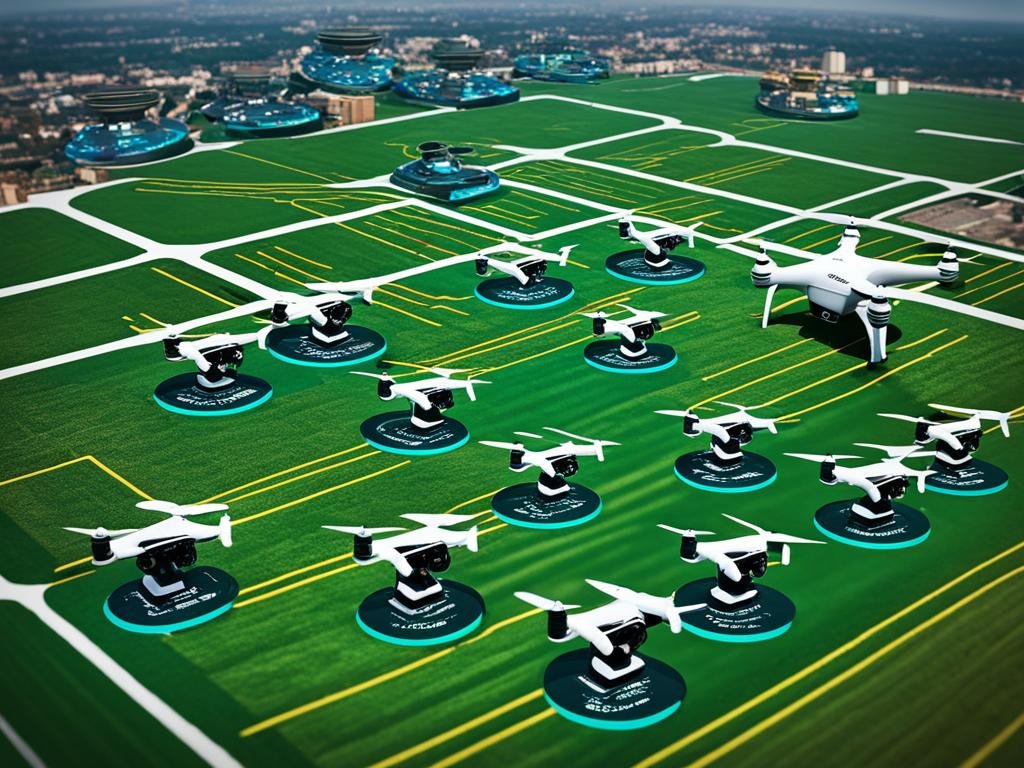
In exploring drone control systems, we find new challenges and exciting updates. We invite our community to learn more about these systems. Find out the true capability of your drone.
Differences in Drone Controls
Exploring Unmanned Aerial Vehicles (UAVs) shows how drone controls vary widely. This variation shapes the flying experience of single motor and multi-rotor drones. It is key to understanding how these amazing machines work.
Single Motor vs. Multi-Rotor Drones
Single motor drones and multi-rotor drones differ greatly. Multi-rotor drones need complex control systems. These systems require an understanding of how to handle multiple motors for better stability and quick responses.
How Drone Transmitters Adapt to Multi-Rotors
Transmitters for multi-rotor drones have become specialized. They manage the challenges of controlling several motors. This ensures pilots can smoothly control their drones.
| Feature | Single Motor Drone | Multi-Rotor Drone |
|---|---|---|
| Controller Complexity | Simple | Advanced |
| Number of Motors Managed | 1 | Multiple |
| Stability & Maneuverability | Basic | Enhanced |
| Flight Dynamics | Fixed | Variable |
| Pilot Interaction | Direct | Complex |
Drone transmitters’ ability to handle multi-rotor systems is key. They ensure pilots stay in control, regardless of how many propellers are flying.
Drone Remote Controller Features
Exploring drone remote controller features uncovers the sophisticated technology behind them. These features are crucial for pilots to achieve best drone control options. They enhance flying, making aerial photography and videography more enjoyable.
FPV Screen Adaptations for Controllers
The use of First Person View (FPV) in controllers has changed the flying game. It lets pilots see from the drone’s view, using screens or smartphones. This makes flying precise, especially for filming or drone races.
Customizing Controls for Enhanced Flight Experience
Being able to customize controls is vital for drone fans. It lets pilots adjust how the controller responds. This personal touch boosts flying skills and comfort.
Understanding Trim Buttons and Their Functions
Trim buttons play a key role in flying drones. They help adjust the drone’s stability mid-air. Knowing how to use these ensures smooth flights even when the weather is tough.
| Feature | Description | Benefit to Pilots |
|---|---|---|
| FPV Screen/Smartphone Integration | Real-time visual feed from the drone’s camera | Enhanced navigational precision and immersive flight experience |
| Control Customization | Adjustable control sensitivity and button layout | Personalized flying experience tailored to the pilot’s preferences |
| Trim Buttons | Micro-adjustments for stability and balance | Increased drone stability and smoother flight experience |
When comparing drone flight control, these details matter. They show how small changes and tech advancements make perfect flights possible. The best drone control options blend innovation, customization, and precision.
How to Choose Drone Controls for Your Needs
Looking for the perfect drone control system means checking if it fits our drone and flying style. We should look at things like FPV screens, button setups, and features for our skill level. By knowing drone controls well, we can pick ones that improve our flying and give us the control we need.
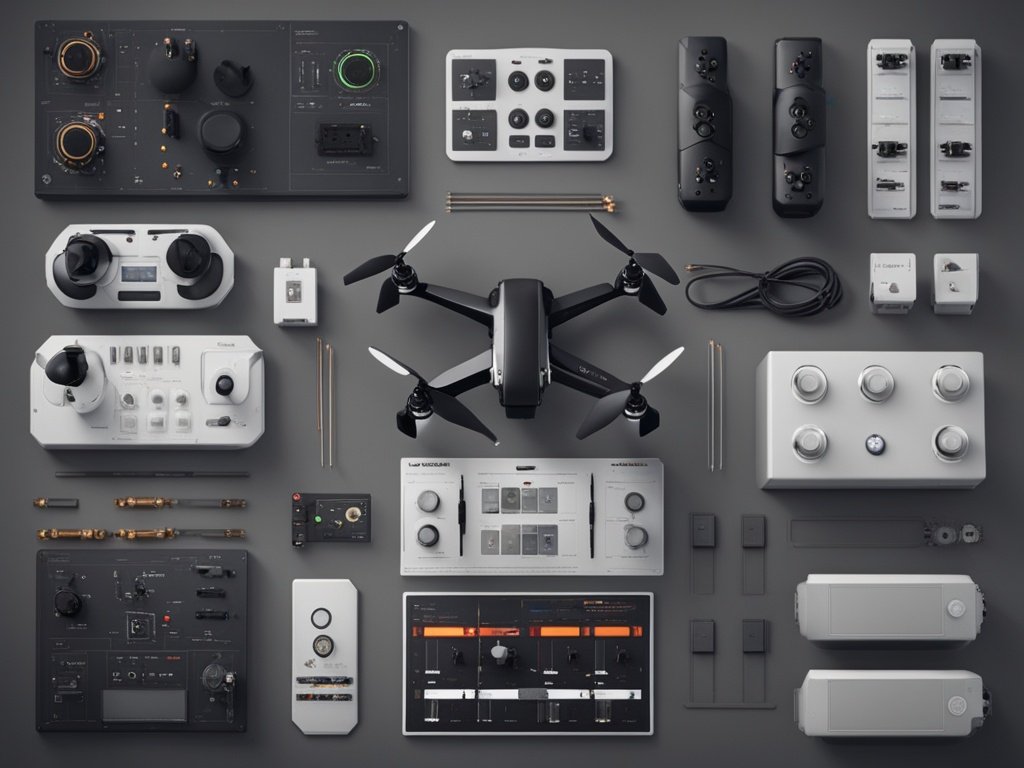
Different pilots need different controls for tasks like taking photos from the sky, racing, or just having fun. Since controllers vary, understanding these differences helps us fly better. Below is a list of key features to think about when picking drone controls.
| Feature | Importance | Beginner-Friendly | Advanced Options |
|---|---|---|---|
| FPV Display | Essential for real-time video feedback | Integrated screen or smartphone compatibility | High-resolution displays, customizable OSD |
| Button Layout | Dictates ease of accessibility to functions | Ergonomic design with labeled buttons | Programmable buttons for complex operations |
| Compatibility | Must match drone model for proper functionality | Manufacturer-specific controls for hassle-free setup | Universal controllers with broad model compatibility |
| Specialized Features | Enhances piloting experience based on usage | Basic telemetry stats for situational awareness | Advanced features like waypoint setting, customizable firmware |
When we know what features we need, choosing the right drone control gets easier. With our new knowledge on drone controls, we can find the perfect match for our drones. It’s about getting controls that make flying feel natural and fun.
Drone Transmitter Variations and Compatibility
Exploring drone transmitter variations shows their complexity. Different types match different drones. Ensuring they work well together is key. It’s vital when picking drone controls. They must fit the drone’s features and the pilot’s needs.
The Case of DJI’s Smart Controller
DJI, a top brand in drones, made the Smart Controller. It works with drones using OcuSync 2.0 technology. This design boosts functionality and ease of use. It shows the push for better compatibility.
Considering Third-party Controllers for Drones
Looking at third-party drone controllers offers many options. They vary in price and features. It’s important to make sure they fit well with your drone. This ensures your drone works safely and well.
Best Drone Control Options on the Market
Searching for the best drone control options can be overwhelming. There are so many choices. Brands like DJI lead with innovative drone remote controller features. Meanwhile, new companies are adding cool features to their controllers too.
For pros, a good controller makes a big difference. It can offer real-time data, FPV views, and comfort for long flights. Nowadays, these high-tech options are more common, fitting the needs of demanding users.
Choosing the right controls is crucial due to the market’s variety. Look for a balance between functionality, ease, and cost. Inspect each controller for battery life, range, and how responsive the controls are.
- Consider the necessity of an integrated screen for FPV versus the use of a separate display.
- Examine the comfort and grip of the controller to ensure precision during flight.
- Evaluate the programmability of buttons for a customized flying experience.
- Assess extra features, like direct social media integration, as these can enhance the usability of the drones for commercial operators.
In the end, it’s not just about the features a controller has. Reliability, easy drone integration, and customer support matter too. Picking a controller that fits how you fly and what you do ensures better control and more fun in the air.
Drone Flight Control Comparison: What Sets Them Apart?
Exploring drones reveals how crucial flight control systems are. They make each drone model unique. These systems combine tech advances to offer precision and ease for pilots of all levels. Let’s start by looking at a key part that influences how drones fly.
Impact of Flight Controllers on Drone Movement
The core of drone stability and movement is the flight controller. This hardware uses complex calculations to turn commands into smooth actions. Its sensors and gyroscopes keep the drone stable, making every flight precise.
Advancements in Control Technologies and User Experience
Innovation is speeding up in drone control tech. New controllers are easier to use and have features like motion sensors. These improve the experience for pilots, making flying a drone more enjoyable.
It’s crucial for pilots to understand differences in drone controls. Knowing about various components helps in choosing the right drone. This knowledge enhances the flying experience.
Conclusion
Exploring the topic Are All Drone Controls The Same? shows us that drone remotes are very diverse. They are designed with different features and technologies. This variety spans from user-friendly designs to more complex systems for professional use.
To truly understand drone control systems, knowing how they impact flying is key. The layout and how well a control responds can change how a drone flies. This means pilots need to know their stuff for the best experience. Also, looking at different drones before choosing one is very important.
Choosing the right drone control system matters, whether for stunning photos or important inspections. Knowledge about what’s out there is essential. Pilots should think about what they need and want from their drone. This way, both hobbyists and pros can make the most out of their flights.
FAQ
Are All Drone Controls The Same?
What Should I Understand About Drone Control Systems?
What Are The Basic Functions of Drone Controllers?
Are Drone Transmitters and Radio Controllers Different?
How Do Drone Controls Vary Between Single Motor and Multi-Rotor Drones?
How Do Drone Transmitters Adapt to Multi-Rotors?
What Are Some Advanced Features of Drone Remote Controllers?
How Can I Choose The Right Drone Controls For My Needs?
What Should I Know About DJI’s Smart Controller?
Is It Worth Considering Third-party Controllers for Drones?
What Are The Best Drone Control Options Available on The Market?
How Do Flight Controllers Impact Drone Movement?
What Are Some Notable Advancements in Control Technologies for Drones?
Source Links
- https://www.quora.com/Is-there-a-standard-configuration-for-drone-controller-lever-and-button-settings-Im-using-a-simulator-and-I-want-to-practice-with-my-controls-set-properly-so-Im-not-completely-surprised-when-I-actually-fly-my-FPV
- https://uavcoach.com/drone-controller/
- https://www.reddit.com/r/BattleBitRemastered/comments/15ixgfn/why_do_drone_and_heli_controls_differ/

